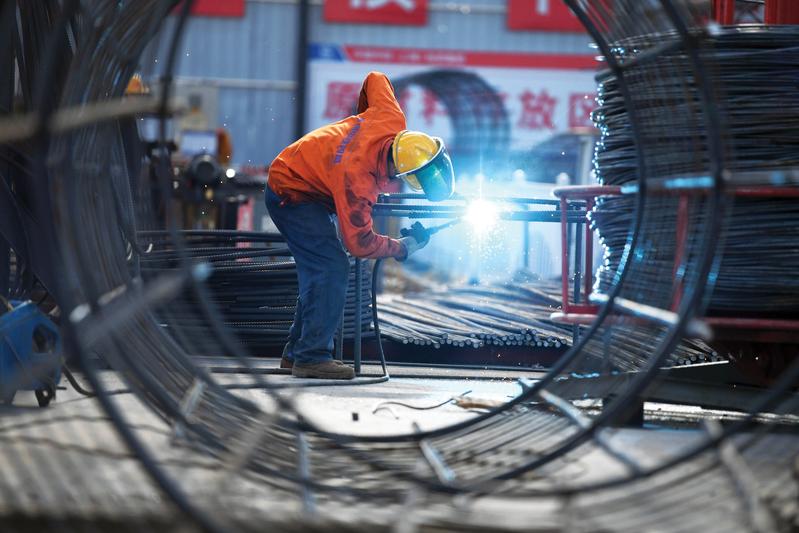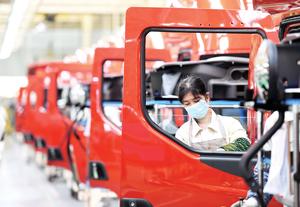China better placed than other major economies to recover, ease the pain globally
 (SONG CHEN / CHINA DAILY)
(SONG CHEN / CHINA DAILY)
Can China lift the world economy out of recession once the COVID-19 pandemic is over?
After the global financial crisis in 2008, the Chinese government put in place the biggest financial stimulus package in economic history.
The 4 trillion yuan (US$570 billion) injection cushioned the Chinese economy from a sudden loss of export demand and led to it generating up to one-fourth of global GDP growth for more than a decade.
With many Western countries mired in debt with little fiscal headroom and no scope to maneuver monetary policy, and with interest rates already at record lows as they tackle the novel coronavirus pandemic, is it possible the world’s second-largest economy could make a similar move this time?
Liu Guoqiang, vice-governor of the People’s Bank of China, said on April 3 that China had “abundant tools and ample policy space” to stimulate the domestic economy.
So far, the PBOC is keeping its powder dry, with the main policy interest rate, the one-year loan prime rate, being kept at 4.05 percent on March 20.
Instead, it has cut the reserve requirement ratio — the percentage banks must hold in reserve at the central bank — so that it can increase lending to businesses. The latest cut of 50 basis points is to be followed by another of the same amount on
May 15, releasing 400 billion yuan into the financial system.
However, in the United States, there is little or no room to adjust rates after the Federal Reserve cut them to near zero on March 15. Four days later, the Bank of England cut its base rate from 0.25 percent to 0.1 percent. The European Central Bank’s main deposit rate is already in negative territory.
In terms of fiscal policy, China is less indebted than many of the world’s leading economies. According to the International Monetary Fund’s World Economic Outlook data in October, the country’s central government debt to GDP ratio was 60.9 percent, compared to the US’ 108 percent, Italy’s 133.7 percent, France’s 99.2 percent and the United Kingdom’s 84.8 percent. The figure for Japan, the world’s most indebted country, was 237.6 percent.
With the State playing a major role in the Chinese economy — for example, in 2018, State assets had a net value equivalent to 100 percent of GDP — the government has much greater scope to increase expenditure.
Sun Mingchun, chief economist at Haitong International Securities, a securities company and investment bank based in Hong Kong, believes China has many advantages over other economies when it comes to lifting itself out of this crisis.
“On the fiscal side, the Chinese government has a lower debt to GDP ratio than most Western countries, even considering its local government debt,” Sun said.
“On the monetary side, both interest rates and the reserve requirement ratio have sufficient room to be cut further. The transmission mechanism of monetary policy to the real economy has also proved more effective in China than in Western countries, at least over the past two decades.”
 A bridge in Anqing, Anhui province, is under construction on April 13. China’s economy is set to play a larger role in global recovery. (LIU JUNXI / XINHUA)
A bridge in Anqing, Anhui province, is under construction on April 13. China’s economy is set to play a larger role in global recovery. (LIU JUNXI / XINHUA)
Zhu Tian, professor of economics at the China Europe International Business School in Shanghai, said this transmission mechanism has the potential to get the economy moving again.
“Unlike in other countries, the main commercial banks are State-owned. Money can be released to them and it goes to businesses who need the cash. This is a major difference to what happens in other financial systems,” he said.
Louis Kuijs, Hong Kong-based Asia head of the consultancy Oxford Economics and a former senior economist for the World Bank, said there is now a significant contrast in the interest rate positions between China and the rest of the world.
“China still has substantial policy space on the monetary front, given that interest rates are still sizable. Unfortunately, central banks in many Western countries have less policy space left in this regard, with their interest rates already on the floor,” he said.
However, Michael Pettis, professor of finance at Peking University, sees things differently.
He said that as the PBOC manages the value of the Chinese currency, this places significant constraints on its ability to command domestic interest rates and money supply, which he suggested is why it has so far left deposit rates unchanged.
“It simply has no room to act without introducing even more serious distortions into the domestic financial system,” he said.
Pettis, who is set to launch the book Trade Wars Are Class Wars: How Rising Inequality Distorts the Global Economy and Threatens International Peace, also warns that any fiscal expansion, particularly for infrastructure investment, may actually weaken the economy.
“China has overinvested in infrastructure for so many years that it is not clear that it can spend money in ways that increase productivity, in which case, unlike other countries that have underinvested in infrastructure, any increase in its debt will not be matched by an increase in its debt-servicing capacity,” he said.
Whatever firepower China has to respond to the crisis, many experts believe it will be reluctant to come up with measures seen on the scale of those in 2008.
While the stimulus, which was unprecedented at the time, stabilized the economy after demand for the country’s manufacturing exports fell by 30 percent in a matter of months, it led to substantial local government debt, which became evident less than three years later in 2011.
George Magnus, a research associate at Oxford University’s China Centre and the School of Oriental and African Studies in London, believes that is why Beijing has been cautious, focusing on delivering bridging finance to businesses that have been disrupted by lockdown measures.
“There’s no question China could do more. The question instead is why not, so far, and what would be the consequences of reverting to yet another round of quasi-fiscal lending, as in 2008 and 2009?” Magnus said.
 Farmers are busy at a flower plantation in Anshan, Liaoning province on April 13. (YAO JIANFENG / XINHUA)
Farmers are busy at a flower plantation in Anshan, Liaoning province on April 13. (YAO JIANFENG / XINHUA)
With escalating death tolls and massive economic disruption in the West, governments there have been forced into action.
The US’ US$2.2 trillion coronavirus aid package became law on March 27 and provides citizens of the country who meet the requirements with a US$1,200 pay check. Canada has granted its newly unemployed citizens US$1,433 a month, while the UK has offered to pay 80 percent of the salaries of furloughed workers.
“The US government’s fiscal programs approximate to 10 percent of GDP. The UK and other European governments have also committed to stimulus or relief programs of comparable size. In contrast, the action taken by China to date amounts to about 3 percent of GDP,” Magnus said.
Some observers have questioned whether the measures put in place by governments worldwide can properly be termed stimulus packages — with much of the world being in lockdown — and might be more aptly called relief programs.
With businesses shut, the global economy is suffering from a supply-side crisis, and such measures are therefore unlikely to have an impact on GDP.
Sun, from Haitong International Securities, said: “In terms of stimulating demand during lockdown time, monetary and fiscal instruments are not very effective.
“All the fiscal and monetary measures introduced so far by governments and central banks are there to maintain the basic functioning of the economy, society and financial markets, rather than to boost economic growth — which seems impossible to me at this early stage.”
Hao Hong, chief strategist and head of research at Bocom International, a financial services company based in Hong Kong, said the measures taken so far have been aimed at averting an even bigger crisis and giving people a means of survival.
“They are mostly to steady the financial markets so as to anchor expectations and confidence before they deteriorate further,” he said.
“Let us hope these short-term policies, such as cash handouts, can ease the short-term pain.”
With China one of the first countries to emerge from the imposition of a lockdown, policymakers around the world are wondering what role the country’s economy can play in any global recovery.
Whether the country can provide the sort of impetus it did after the global financial crisis remains to be seen.
Douglas McWilliams, deputy chairman and founder of the Centre for Economics and Business Research, a consultancy based in London, believes that China could have an even bigger impact than it did 12 years ago.
 A factory in Liuzhou, Guangxi Zhuang autonomous region is busy manufacturing vehicles on April 13. (LI HANCHI / XINHUA)
A factory in Liuzhou, Guangxi Zhuang autonomous region is busy manufacturing vehicles on April 13. (LI HANCHI / XINHUA)
He said this is because the Chinese economy now comprises 17 percent of global GDP, compared with 10 percent in 2010.
“Even if China only grew at the same rate as the rest of the world, it would generate nearly one-fifth of global GDP growth. However, we expect China to grow on average rather faster than the rest of the world. So, generating at least a quarter of global GDP growth is highly likely,” he said.
“China, this time round, will also be boosting global GDP by its contribution to world infrastructure investment, particularly through the Belt and Road Initiative.”
Shan Saeed, chief economist at IQI Global, an investment company in Kuala Lumpur, Malaysia, believes that Chinese consumers could play a major role this time.
He said the power of such consumers can be gauged by their spending on overseas trips — US$288 billion in 2018, double the US$144 billion spent by US citizens.
“China’s consumers still have further room to leverage their savings, having one of the highest ratios of savings to disposable income among the leading countries in the global economy,” he said.
“Their savings amount to US$2.5 trillion and most global banks are chasing those funds.”
However, Zhu, from CEIBS, rejects any argument that China drove world growth after the global financial crisis, and suggests that the world should not be looking for a helping hand from the country this time.
“If China’s growth is 10 percent, then mathematically, it obviously contributes to global growth, but it is wrong to draw the conclusion that if other countries are growing at 5 percent, China is somehow contributing to that. There is not such a big correlation. Nobody is lifting anybody,” he said.
Whatever impact China may have on global recovery, most economists fear the pandemic will trigger a major recession.
The economic shutdown in many countries came at a time when the global economy was overdue for a correction, having experienced one of the longest upward cycles in economic history, since the global financial crisis.
Some commentators believe the compound effect of this could result in the 2020s becoming a repeat of the Great Depression in the 1930s.
Michael Spence, professor of economics at New York University’s Stern School of Business and a Nobel Prize winner for economics, said this is not inconceivable.
“There would have to be a lot of mistakes made to get there. The main risk is the poorer developing countries. They are highly vulnerable, both medically and economically,” he said.
“If they don’t get help from the G20, international financial institutions and generally from other countries, they could be in a grim situation,” Spence said.
Zhu Ning, deputy dean and professor of finance at the Shanghai Advanced Institute of Finance, said the problems of the 1930s were compounded by the wrong policy response (deflationary rather than expansionary) and he is concerned that the action taken by governments this time might be ineffective.
“Global coordination is required to boost global demand once again. This will probably be more challenging after the pandemic is over, because the relatively lower hanging fruits (in terms of policy tools) have already been plucked in the aftermath of the previous crisis just over a decade ago,” he said.
 A South Korea-invested factory in Qingdao, Shandong province is busy with producing machines for the manufacture of protective gowns on April 12. (LI ZIHUAN / XINHUA)
A South Korea-invested factory in Qingdao, Shandong province is busy with producing machines for the manufacture of protective gowns on April 12. (LI ZIHUAN / XINHUA)
McWilliams, from CEBR, said if the pitfalls of the 1930s are to be avoided, trade wars have to be “well and truly” off the agenda once the pandemic ends.
“One of the big mistakes of the 1930s was to follow beggar-thy-neighbor policies, imposing tariffs and limiting international trade,” he said.
“The fiscal and monetary authorities also allowed the initial recession to spread by not taking action to prevent businesses shutting down and people losing their jobs. The result was a vicious circle of lower activity, leading to lower incomes, leading to lower spending, leading to lower activity. This has to be avoided this time.”
Magnus, from Oxford University, said it is unrealistic to assume that economies can be shut down temporarily and then experience steep, so-called V-shaped recoveries, with everything returning to normal.
“The longer the lockdowns persist, even if only in partial or reduced form, and the longer people think that it’s not safe yet (to engage in economic activity), the greater the chance you have of getting what economists call hysteresis, which is where sharp dislocations in the economy and in employment that we hoped were temporary become permanent,” he said.
“This is unquestionably possible, because we don’t yet know what a reliable exit strategy is from the lockdowns, or what the risks are of a second wave of mass infections when restrictions are eased.”
One thing that is certain is that after the pandemic, economies are going to be burdened with much more debt, even from the emergency financial measures taken to date.
Multiple countries have already had to cope with a decade of austerity measures to reduce debt incurred while dealing with the financial crisis.
Many economists believe it would be dangerous for policymakers to impose such measures this time.
SAIF’s Zhu Ning, the author of China’s Guaranteed Bubble, an analysis of how the country’s financial system is ultimately marshaled by the government, said everyone would have to get used to higher debt levels for a long time.
“The whole world will be living through an era of higher debt. We will have to maintain low interest rate regimes to alleviate this. The debt overhang will probably hinder any strong economic rebound,” he said.
Spence, from New York University, also a senior fellow at the Hoover Institution, a public policy think tank, said it would be a huge mistake to introduce severe austerity measures, and that optimism needs to be drawn from what happened after World War II.
“Austerity would just kill growth. We have to accept high debt levels for now, and some distortions, and then grow our way out of the debt overhangs, as in the case of the postwar experience,” he said.
Sun, from Haitong, believes that of all the major economies, China is better placed to recover more rapidly and ease the pressure on others.
“China is probably best positioned to sail through this storm, as it has abundant room for policy responses and more household savings,” he said.
“Chinese consumers will also play a big role this time. Consumption has become a much larger growth engine for China today than it was 10 years ago.”



